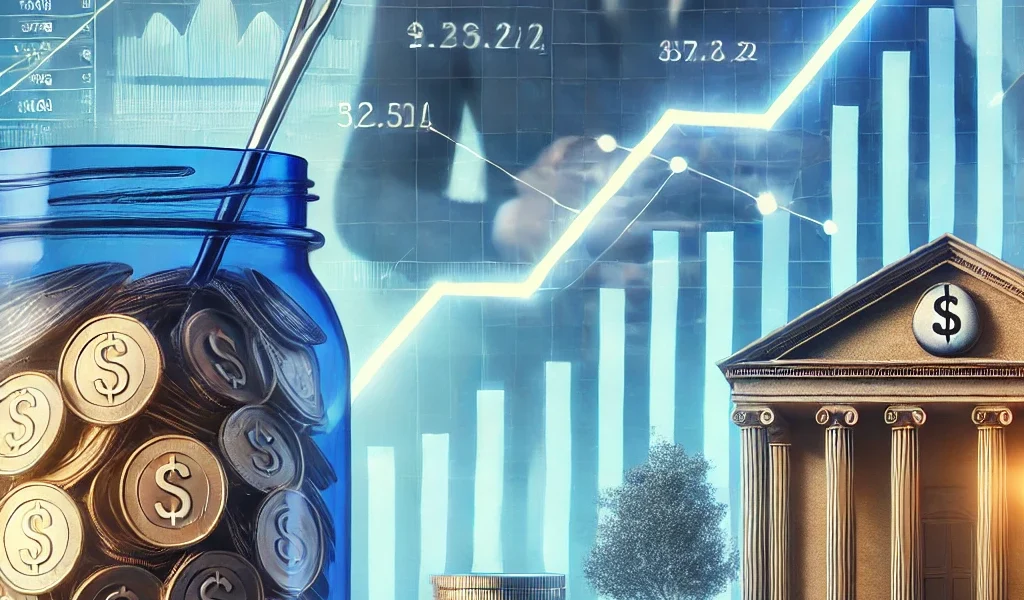In today’s financial landscape, finding a secure way to grow your savings is essential. High-yield savings accounts (HYSAs) offer a great balance between safety and earning potential, making them an attractive option for individuals looking to maximize returns without taking significant risks. In this guide, we will explore the best high-yield savings accounts, their benefits, and factors to consider before choosing one.
What is a High-Yield Savings Account?
A high-yield savings account is a type of savings account that offers a significantly higher interest rate than traditional savings accounts. These accounts are typically offered by online banks, credit unions, and some traditional banks aiming to attract customers with better returns on their deposits.
Key Features of High-Yield Savings Accounts:
- Higher Interest Rates – Earn more compared to regular savings accounts.
- FDIC/NCUA Insurance – Your money is protected up to $250,000.
- Easy Accessibility – Most accounts allow online transfers and withdrawals.
- No or Low Fees – Many HYSAs offer fee-free banking or low minimum balance requirements.
- Compound Interest – Interest is typically compounded daily or monthly to maximize earnings.
Benefits of High-Yield Savings Accounts
- Higher Interest Rates – Compared to traditional savings accounts, which offer rates as low as 0.01%, high-yield accounts can provide 4-5% APY.
- Low Risk – Unlike stocks or cryptocurrencies, your deposits are secure and insured.
- Liquidity – Easily access funds while earning interest, making it an ideal option for an emergency fund.
- Minimal Requirements – Many online banks offer high interest with no minimum deposit or monthly fees.
- Financial Growth – Even with small deposits, compounding interest helps money grow over time.
Top High-Yield Savings Accounts in 2025
| Bank | APY (Annual Percentage Yield) | Minimum Deposit | Monthly Fees |
|---|---|---|---|
| Ally Bank | 4.25% | $0 | None |
| Marcus by Goldman Sachs | 4.30% | $0 | None |
| Discover Bank | 4.20% | $0 | None |
| Capital One 360 | 4.10% | $0 | None |
| CIT Bank Savings Connect | 4.50% | $100 | None |
| Synchrony Bank | 4.35% | $0 | None |
| American Express Savings | 4.20% | $0 | None |
How to Choose the Best High-Yield Savings Account
- Compare APY Rates – Higher APY means better earnings on your savings.
- Check Fees and Minimum Balance Requirements – Opt for an account with no monthly fees and low or no minimum balance requirements.
- Look for Accessibility & Features – Ensure the bank offers easy online banking, mobile app access, and customer support.
- Verify FDIC/NCUA Insurance – Ensure the bank or credit union provides coverage up to $250,000.
- Review Withdrawal Limits – Some accounts may have transaction limits that restrict the number of monthly withdrawals.
Who Should Open a High-Yield Savings Account?
- Individuals Saving for Short-Term Goals – Ideal for vacations, home purchases, or emergency funds.
- People Looking for a Safe Investment – Provides a low-risk way to grow money while keeping it accessible.
- Those Frustrated with Low Bank Interest Rates – Offers significantly higher returns than traditional savings accounts.
- Retirees and Fixed-Income Earners – Ensures steady, risk-free growth without market fluctuations.
Common Myths About High-Yield Savings Accounts
1. High-Yield Savings Accounts Are Risky
No, they are FDIC- or NCUA-insured, meaning your funds are protected up to $250,000 per account holder.
2. Higher APY Always Means Better Returns
While APY is important, factors like withdrawal limits, fees, and customer service also matter.
3. You Need a Large Deposit to Open an HYSA
Most high-yield accounts require no minimum deposit, making them accessible to everyone.
4. You Can Withdraw Money Anytime Without Limits
Many banks limit withdrawals to six per month, so they are not the best for frequent transactions.
How to Open a High-Yield Savings Account
- Choose a Bank – Compare APYs, fees, and features.
- Gather Documents – Typically, banks require an ID, Social Security Number (SSN), and proof of address.
- Apply Online – Most high-yield savings accounts can be opened in minutes through an online application.
- Fund Your Account – Transfer money to start earning interest immediately.
- Set Up Automatic Transfers – To maximize growth, set up recurring deposits.
Tips to Maximize Returns on High-Yield Savings Accounts
- Keep Adding to Your Savings – The more you save, the more interest you earn.
- Avoid Withdrawals – Reducing transactions helps maintain higher balances for maximum growth.
- Monitor APY Changes – Interest rates fluctuate, so stay updated and switch banks if needed.
- Use Multiple Accounts – Spreading money across different banks can help you take advantage of better APYs.
FAQs About High-Yield Savings Accounts
1. What is the average APY for high-yield savings accounts?
The average APY in 2025 ranges from 4.00% to 4.50%, depending on the bank.
2. Are high-yield savings accounts better than CDs?
HYSAs offer more liquidity, while certificates of deposit (CDs) usually have higher fixed interest rates but require locking funds for a set period.
3. Can I lose money in a high-yield savings account?
No, as long as the bank is FDIC-insured, your money is protected up to $250,000.
4. How often is interest compounded?
Most banks compound interest daily or monthly, allowing your balance to grow faster.
5. Is there a limit on how much I can deposit?
Most banks do not have a maximum deposit limit, but FDIC insurance only covers up to $250,000 per depositor.
Final Thoughts
High-yield savings accounts are one of the best ways to grow your money safely while maintaining access to your funds. By choosing the right bank and understanding account features, you can maximize your savings and earn competitive returns without taking unnecessary risks.
If you’re looking for a safe and flexible way to grow your savings, a high-yield savings account is an excellent option. Start comparing the best rates today and take control of your financial future!




